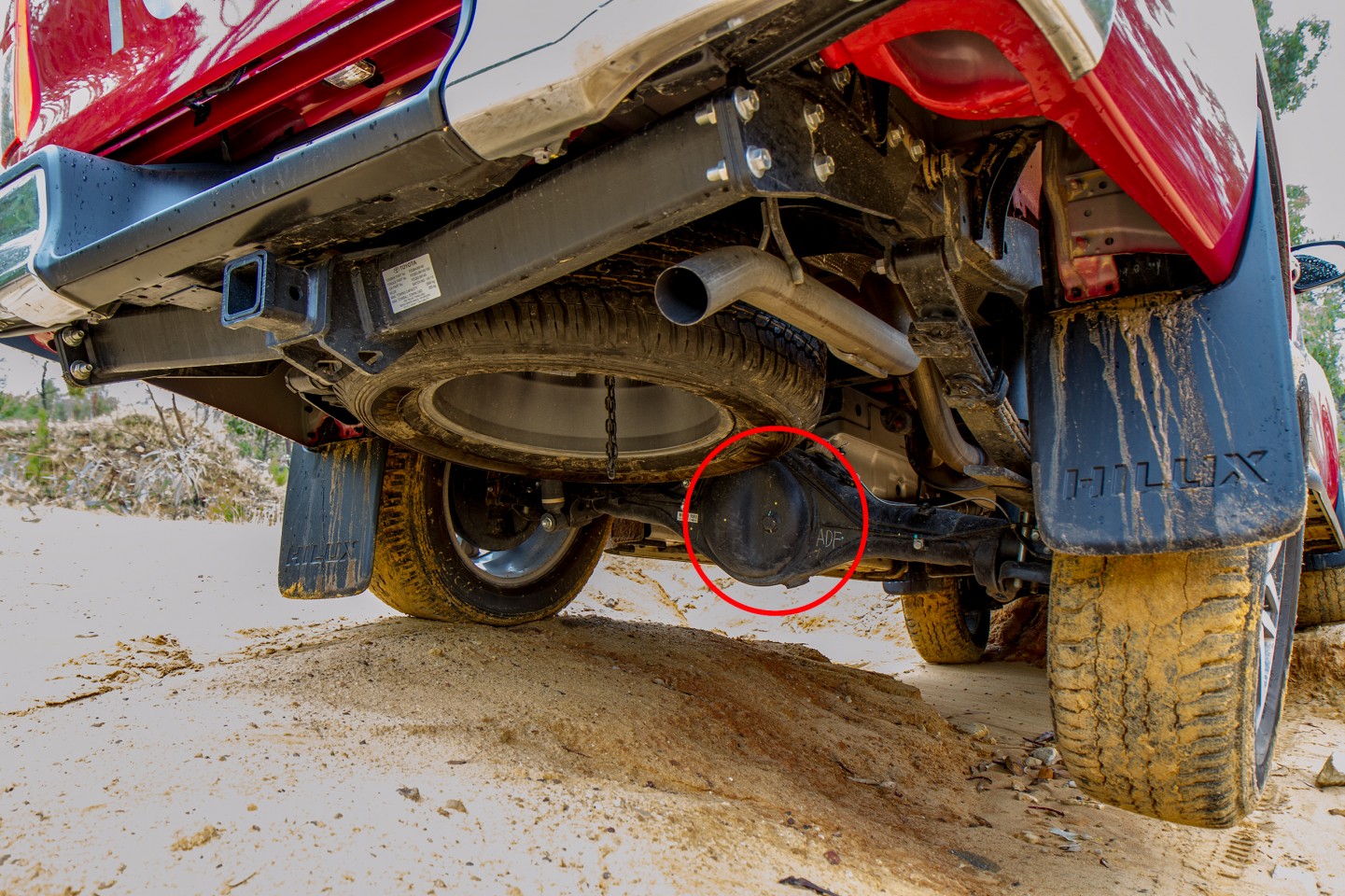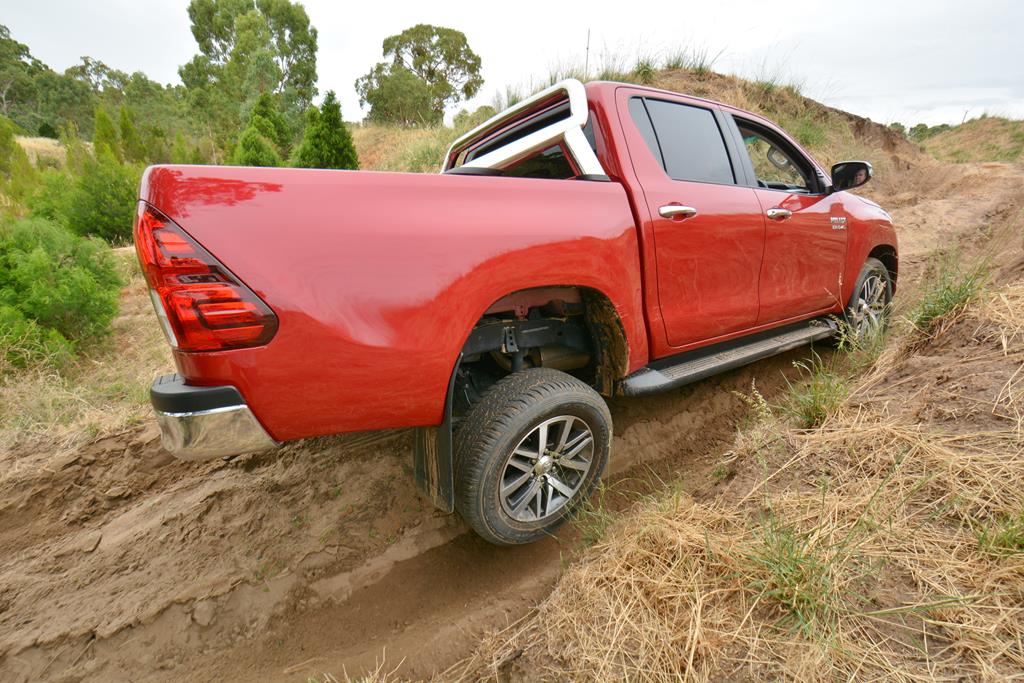Often when I’m running a course and explaining a 4WD driveline I’ll have people confused about the forms differentials take and muddle up the ones in the axles with the ones seen in the centre, so I thought I’d spend a moment and explain the differences in an easily digestible form. If you’re a new 4WD salesperson it might pay you to pay attention, because there are a lot of mightily confused consumers out there, after you’ve had a chew of their ear!
Firstly let’s look at the differentials seen in the centre of the axles, those big black round blobs sitting roughly mid-ships in the front and rear of any fourbie.

That’s the differential housing inside the red circle. Also known as the ‘diff pumpkin’.
The job they have to perform on a 4WD is many and varied. Inside that housing is a clever collection of gears that spin around and drive the wheels by changing the direction of the energy (torque) from the motor travelling north-south (down the length of the vehicle), to east-west and out to the wheels.
Additionally have you ever considered what goes on when you go around a corner?
Again that collection of gears allows the wheels from one side of the car to the other to speed up or slow down, critical to getting around a corner, for without that feature roads would have had to be built a lot straighter!
So if we turn left, the inside radius wheels (the left ones) will travel a lesser distance and therefore slower than the outside wheels (the right ones) which have to speed up and travel a bigger distance. This gets even more complicated if you are in 4WD on a part-time vehicle or you’ve got a full-time vehicle, because the front will want to rotate at a speed different to the back! More on that later.

A vehicles wheels rotate at different speeds when cornering and the differential allows opposing wheels to do this.
Now differentials in axles have had a number of different configurations in the time they’ve graced your typical 4WD vehicle. There’s open diffs (a differential centre with no traction-enhancing mechanism), LSD or limited-slip differential (a differential aided in the traction stakes with clutch plates and springs) and locking differentials (a differential that has a coupling that joins or locks each axle half together so they rotate at the same speed). Each has performed a role dependent on what the expectation for that vehicle has been in performing off-road or on slippery surfaces.
An open diff is the one that’s likely to get you into trouble pretty quickly as there’s zero traction enhancing facilities inside its workings. Think here of Series1 Land Rover Discoveries. Rover worked on the off-road premise of mobility provided by heaps of wheel articulation in the form of coil springs front and rear coupled to beam axles and provided you could keep a wheel in contact with the ground you’d go places.
Of course in extreme lumps and bumps a wheel will inevitably go light and once that grip is lost the diff will send the torque it’s receiving out through the path of least resistance. Most drivers when they recognise that moment do exactly what they shouldn’t and bury their foot on the accelerator! The result… a spinning wheel that digs a big hole!

Open diffs are lazy and if traction is lost at one wheel as seen here, the diff will push all available torque to that wheel. A good LSD or electronic traction control system will stop the wheel lacking traction from spinning and force torque to the opposite wheel. A locking diff locks the back axles (half shafts) and puts torque through to both opposing wheels regardless of the situation.
Now the Japanese noted early in the piece that that wheel-spin was going to cause some problems, so they introduced the LSD to just about every 4WD they made that I can remember in the 70’s through to only just recently. In that same wheel-lifting moment, provided the offending wheel wasn’t over-sped (that means getting your foot off the accelerator), there’d be a chance that the clutch plates in the diff would couple and brake the now spinning wheel and that torque potentially lost via that spinning wheel is transferred across the axle to the wheel that has grip. Very simple, but sadly not bankable across different makers products.
A case in point is Nissan’s Navara range. I had a couple of D40s, great utes, but the LSD was utterly useless. Nissan techs had a couple of goes at trying to tweak them for me but the design was flawed as they couldn’t supply enough friction force at the time of slip to do any good. Contrast that to the D22, the ones I drove at different times were almost like a locker and hooked up quickly when required off-road yet were unobtrusive on-road.

ARB diff locker cutaway image
Then there’s the locking differential. There are a few forms of these one of the most obvious is ARB’s Air-Locker, something I have in the back axle of my DMAX in the absence of one offered by Isuzu as an option.
The modern idiom of ute construction is to use an IFS (independent front suspension) instead of the old beam axle style seen in the rear, the benefit being a flatter and more controlled car-like ride on the bitumen courtesy reduced front wheel travel. The downside (you know the story, giveth with one hand, and taketh with the other) is a vehicle that wants to wag a wheel in the air and we know from what we’ve discussed already that that will cause some problems in the mobility stakes.
Ford and Mazda on the Ranger and BT-50, Volkswagen with Amarok and Mitsubishi with the Triton offer a locking rear differential for those of us who want to explore and I’d recommend it highly to you. If you’ve got any aspirations for travelling in interesting country I reckon it’s essential. At slow speeds (try walking pace) when you identify a hazard (say a gully crossing your path), engage the rear diff-lock. You’ll likely hear a subtle clunk/click as the back axles join up and that chasm that was in front of you moments ago has now been dealt with, no fuss! As soon as you’re back on terra-firma turn it off. Treat it as a low-speed “get out of jail free card”.
Alright, that’s the axles dealt with. What about the other one then?
If you’re running a full-time 4WD and in fact an AWD (notice I don’t call them SUVs – hate that term) you’ll have a centre-differential.
This type of driveline was conceived in lands far, far away, where stuff falls out of the sky more frequently than we see here in Oz (well at least more frequently than I see here in SA) – rain!
The problem with either a RWD (rear wheel drive) or a FWD (front wheel drive) vehicle is a lack of grip on wet or icy surfaces and with that comes dangerous over or understeer. Now electronics have assisted mightily in the traction stakes with the advent of safety systems hanging off ABS (anti-lock braking systems). Both ETC (electronic traction control) and VSC (vehicle stability control) seamlessly go to work when your on-road situation turns to poo. That’s good as they’ll save countless lives of drivers who have a skills deficit.

Bad things can happen even with ASC on, as this HiLux undergoing moose testing shows
Now we all know that a 4WD in 4WD has heaps more grip on loose surfaces than one stuck in 2WD. So using that thought bubble vehicle manufacturers came up with an idea of having a vehicle that could run in a form of 4WD on a hard surface without screwing up its transmission! Very clever.
The first serious incarnation of this thinking in a 4WD was the Range Rover, a vehicle still regarded highly today as a serious weapon off-road, whilst possessing uber-luxury appeal for the well-heeled swanning around town (it’s a pity virtually none of them go bush).
So to achieve its extra ability on-road without transmission-busting “wind-up”, Land Rover plonked a differential in the transfer case, the “centre-differential”, a stroke of genius. Remember one of the primary roles of an axle differential is to allow the wheels to rotate at different speeds when going around a corner. Apply that concept to a driveline that then allows the front end to turn at a different speed to the back end. No conflicting inputs from different wheels that would result in an expensive bang because they’re cancelled out before they do any damage!

The Mitsubishi Super Select system – 4H is AWD for use on hard surfaces with the centre diff open and 4HLC is 4WD for use on loose surfaces with centre diff locked.
Now the bulk of these full-time machines (I’m talking any of Land Rover’s 4WD family, Mitsubishi with the “Super-Select” Pajero and Triton, Jeep with Grand Cherokees, Toyota’s 200 and Prado and Ford’s Everest) have a torque-bias that favours more energy served up to the back end of the vehicle compared to the front. Typically the value is around 60/40 or 70/30.
That might seem odd why not go straight to 50/50?
The rationale is to still make the driving experience around town a comfortable one by not loading up the steering too heavily enjoying all the safety benefits of what effectively on the bitumen is AWD (all-wheel drive) like Subaru have made their safety staple.
There is a full-time machine that does go 50/50 on the bitumen and that is Suzuki’s Grand Vitara. Suzuki and now a lot of others offer electric power steering instead of the traditional hydraulic systems which offer a lot more variability than before, so steering loads at various speeds can be compensated for.

Now off-road a torque imbalance and a centre-differential that is “open” isn’t going to fare too well once the grip is compromised (remember my earlier discussion about axles with no traction enhancing ability), so the trick to fix that is to lock the centre differential. There’ll either be a button or a knob or lever to perform that function and once employed your full-timer will be locked in a 50/50 mode for loose surfaces only. Drive in this mode on bitumen and your 4WD won’t like you one little bit!
Because the front end and back are now effectively joined in the middle instead of being kind of hinged, there’s no free-play in the driveline to cancel out wind-up. As soon as the corners emerge uneven amounts of rotation from side to side and front to back twist up the gubbins underneath until something goes snafu… that moment will be expensive!
So there you have it, differential 101, a lesson in automotive design that everyone should understand.





GIPHY App Key not set. Please check settings